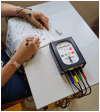Improving Sleep Quality and Well-Being in Institutionalized Older Adults: The Potential of NESA Non-Invasive Neuromodulation Treatment
- PMID: 39846574
- PMCID: PMC11755576
- DOI: 10.3390/geriatrics10010004
Improving Sleep Quality and Well-Being in Institutionalized Older Adults: The Potential of NESA Non-Invasive Neuromodulation Treatment
Erratum in
-
Correction: Báez-Suárez et al. Improving Sleep Quality and Well-Being in Institutionalized Older Adults: The Potential of NESA Non-Invasive Neuromodulation Treatment. Geriatrics 2025, 10, 4.Geriatrics (Basel). 2025 Jun 30;10(4):86. doi: 10.3390/geriatrics10040086. Geriatrics (Basel). 2025. PMID: 40679851 Free PMC article.
Abstract
Background/Objectives: Ageing is associated with several cognitive, physical, and emotional changes, including a decrease in sleep quality and mental health issues. This study studies NESA (Spanish acronym for Neuromodulación Superficial Aplicada) non-invasive neuromodulation using microcurrents as something that may provide a potential improvement in the quality of sleep and general health of older adults and residents in a healthcare institution. Methods: This observational study recruited 24 people who were residents at a long-term care facility. Participants were divided into two groups: one intervention group, who underwent NESA therapy twice a week for a total of 20 sessions, and a control group, who did not receive this treatment. The outcomes measured include sleep quality (Pittsburgh Sleep Quality Index), diary of sleep, symptoms of depressed mood (Yesavage Geriatric Depression Scale), and quality of life with the World Health Organization Quality of Life-Old (WHOQOL-OLD). Scores were collected at baseline, after 10 and 20 sessions, and 3 months after finishing the treatment. Results: The intervention group exhibited a notable improvement in sleep quality (p = 0.05). Additionally, there were fewer nocturnal awakenings. The quality of life also showed better scores, especially in relation to social relations and physical and mental health, which matches the slight decrease in scores and clinical improvement regarding depressive symptoms. In contrast, the control group demonstrated no improvement in symptoms, and in some cases, there was a worsening of symptoms. Conclusions: Our findings indicate that NESA non-invasive neuromodulation therapy is likely to enhance sleep quality and health-related measures in institutionalized older adults. Despite the limitations of the current study, the results support the potential of NESA microcurrents to enhance the well-being of this population.
Keywords: autonomic nervous system; geriatric nursing; geriatrics; mental health; sleep quality.
Conflict of interest statement
The authors declare that the research was conducted in the absence of any commercial or financial relationships that could be construed as a potential conflict of interest.
Figures
Similar articles
-
Antidepressants for pain management in adults with chronic pain: a network meta-analysis.Health Technol Assess. 2024 Oct;28(62):1-155. doi: 10.3310/MKRT2948. Health Technol Assess. 2024. PMID: 39367772 Free PMC article.
-
Pharmacotherapies for sleep disturbances in dementia.Cochrane Database Syst Rev. 2016 Nov 16;11(11):CD009178. doi: 10.1002/14651858.CD009178.pub3. Cochrane Database Syst Rev. 2016. Update in: Cochrane Database Syst Rev. 2020 Nov 15;11:CD009178. doi: 10.1002/14651858.CD009178.pub4. PMID: 27851868 Free PMC article. Updated.
-
Psychological therapies for post-traumatic stress disorder and comorbid substance use disorder.Cochrane Database Syst Rev. 2016 Apr 4;4(4):CD010204. doi: 10.1002/14651858.CD010204.pub2. Cochrane Database Syst Rev. 2016. PMID: 27040448 Free PMC article.
-
Pramipexole in addition to mood stabilisers for treatment-resistant bipolar depression: the PAX-BD randomised double-blind placebo-controlled trial.Health Technol Assess. 2025 May;29(21):1-216. doi: 10.3310/HBFC1953. Health Technol Assess. 2025. PMID: 40455248 Free PMC article. Clinical Trial.
-
Acupuncture for treating fibromyalgia.Cochrane Database Syst Rev. 2013 May 31;2013(5):CD007070. doi: 10.1002/14651858.CD007070.pub2. Cochrane Database Syst Rev. 2013. PMID: 23728665 Free PMC article.
Cited by
-
Correction: Báez-Suárez et al. Improving Sleep Quality and Well-Being in Institutionalized Older Adults: The Potential of NESA Non-Invasive Neuromodulation Treatment. Geriatrics 2025, 10, 4.Geriatrics (Basel). 2025 Jun 30;10(4):86. doi: 10.3390/geriatrics10040086. Geriatrics (Basel). 2025. PMID: 40679851 Free PMC article.
References
LinkOut - more resources
Full Text Sources



